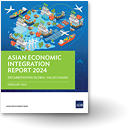Leveraging Asia’s investment potential for a green recovery
Developing Asia is estimated to have fended off the scarring impact of investment decline relatively well during the pandemic compared to other developing regions such as Latin America and Africa. For example, the People’s Republic of China and India still posted a positive growth rate in FDI in 2020. Meanwhile global FDI flows collapsed in 2020, falling by 35%, their lowest level since 2005, according to the UN. The impact was felt the most in developed countries where FDI declined by 58%, while developing countries weathered the storm better, with an 8% decline. Latest estimates for the first quarter of 2021 suggest an overall 10% decline for global FDI flows and 12% for Asian FDI inflows, according to firm level data. Adding to this is the fact that the pandemic has prompted economies, in the region and globally, to implement stricter screening and regulatory measures to oversee FDI. While the arguments for these restrictive measures are compelling from the perspective of national security or public health, economic impact and implications should be taken into account. Policy makers in the region could also seize the moment as an opportunity to introduce higher social and environmental standards for investment.
FDI continues to be an important source of external financing for developing Asia in particular, with FDI inflows growing 2% on average since 2001. This represents nearly 4.5% of developing Asia’s GDP in 2019. The region’s attractiveness as a manufacturer of intermediate goods and a place of final assembly, as well as a host in the expanding domestic market, has provided a strong impetus for multinationals to invest in developing Asia. However, growing obstacles to FDI may dampen this momentum.
Contrary to the 2008 crisis, where many countries chose to open up further to foreign capital, the pandemic brought a new surge in investment restrictions, both globally and in Asia. Measures included, for example, entry and establishment regulations such as business permits, approval requirements, operational restrictions and limitations to foreign investment in certain sectors. These measures have aimed to protect health-related activities and safeguard strategic sectors from possible predatory takeovers during the pandemic.
Historically, and despite ambitious reforms over the past two decades, Asian economies have imposed higher restrictions on foreign investment than industrialised economies. These measures are more stringent in service sectors. Barriers are particularly higher in business services, such as legal services, accounting or engineering in some Asian economies. Other features, such as market size and natural-resource endowments, are also related to higher investment restrictions.
Evidence points towards a negative association between increasing restrictions and inward FDI. Further, restrictive measures can prove harmful to competition, raise input costs for associated economic sectors, and hamper countries’ potential to move up the value chain. By reducing a country’s attractiveness to FDI, investment restrictions also limit the potential for positive spillovers through knowledge and technology transfer.
Meanwhile, multinationals are under growing pressure to comply with environmental, sustainability and social responsibility standards across borders. Environmental, Social and Governance (ESG) investing is gaining momentum, reflecting the crucial role of investment towards reducing carbon footprint, creating quality jobs, developing human capital and helping achieve other sustainable development goals. The pandemic has accelerated this trend, with ESG investments now gearing towards COVID-responsive sectors, including renewable energy, telecommuting, distance learning and telehealth. Foreign invested enterprises will be under no less pressure than domestic firms on the ESG front, and rightly so.
In order to prepare for and fully benefit from the potential of ESG in foreign investment, Asian economies could intensify policy efforts. First, countries need to ease and further rationalise investment restrictions; this is increasingly important to uphold investment principles – openness, transparency, fairness – and to foster the growth of key industries, such as digital services, which are expected to expand in the future through capital expansion and stronger competition. Second, in the same way as multinationals are recalibrating their investment models to encompass ESG objectives, Asian governments can proactively adopt new investment standards. This requires improving transparency and accountability in investment protocols and introducing monitoring and evaluation systems to track investment footprint in the years to come. Such measures can attract quality FDI and help strengthen economic resilience. Finally, having stronger investment treaty regimes will certainly help create an enabling environment for FDI and reinforce provisions that give precedence to public interest and non-economic standards. The region can build on its existing network of investment treaties.
Asia’s resilience to the FDI shock during COVID-19 has been remarkable and its regional value chains are closely embedded into its investment nexus. Despite this progress, it is essential to consider how investment measures can adapt to a changing environment. Investment policy may evolve in a way that neither deters foreign investment nor misses the opportunity to induce quality investment through open, transparent and higher standards.
Original article was published at the OECD Development Matters and duplicated here with permission from the authors. *




